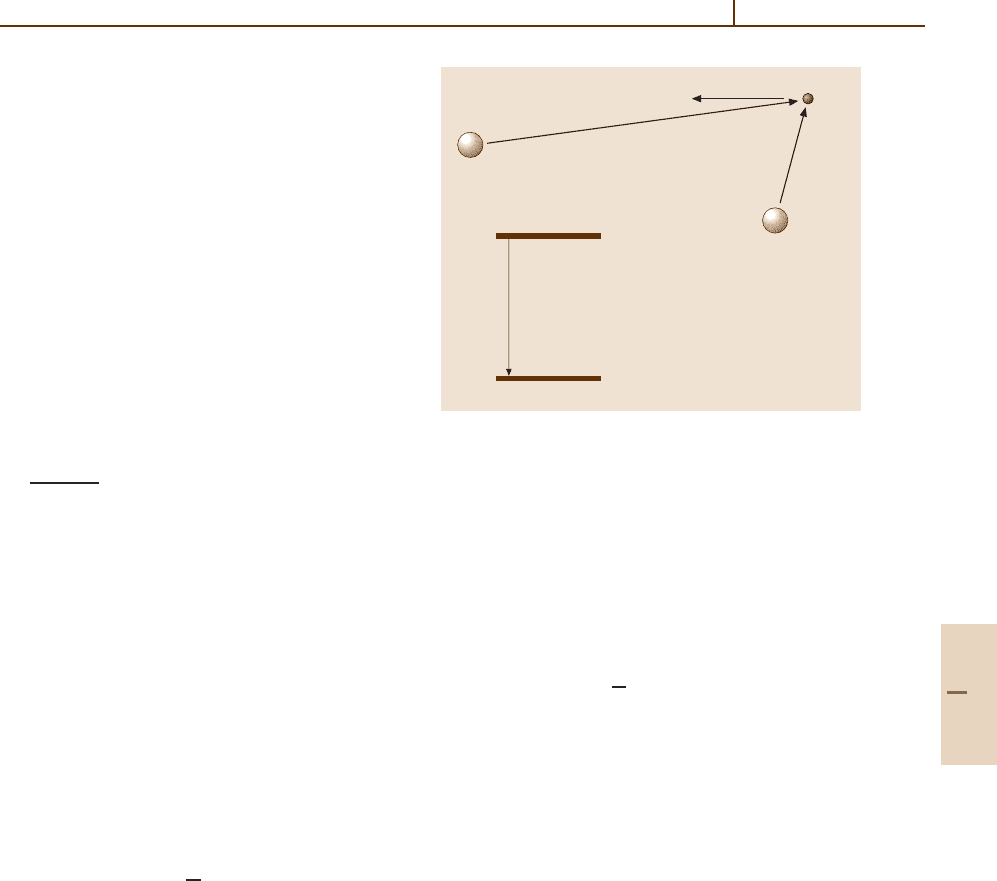Drake G.W.F. (editor) Handbook of Atomic, Molecular, and Optical Physics
Подождите немного. Документ загружается.


794 Part D Scattering Theory
from isotropic inital states are distributed symmetrically
about this axis, i. e., about 90
◦
, in first approxima-
tion. Because q is averaged over in forming the cross
section, all directions contribute to some extent, and
the distribution is not completely symmetric. The solid
curve in Fig. 53.3 represents a distribution computed
in the Bethe–Born approximation, and it is seen to
peak at 90
◦
but is somewhat asymmeteric about this
angle, reflecting effects of averaging over the direc-
tion of q. Such distributions are well described by
only a few partial waves for the outgoing electron. In-
deed, the theoretical distribution is well described by
a combination of s and p waves. The calculations fit
the experimental data except in the forward direction
where the experimental distribution increases sharply.
Such sharp increases must reflect the presence of many
partial waves not described by the Born approximation.
Since the main disagreement between theory and ex-
periment is confined to a small angular region near
0
◦
which contributes only a small part to the total
cross section, the Bethe–Born approximation represents
a well-founded theoretical framework for interpreting
features that appear in the low-electron-energy portion
of the DDCS.
While the main contribution to total ionization cross
sections comes from the low energy region, electrons
in the high energy region (v/2 < k) carry more energy
per electron, and therefore play a prominent role in pro-
cesses initiated by fast electrons. The fast electrons on
the Bethe ridge correspond to collisions where the mo-
mentum q lost by the incident projectile is transferred
mainly to the ejected electron. Because the momen-
tum k of the ejected electrons is much larger than the
mean value of the electron momentum in the initial
state, given by
√
2ε
i
, this portion of the spectrum can
be interpreted in terms of a binary collision between
the incident projectile and the target electron treated as
quasifree. By quasifree we understand that the electron
has a nonzero binding energy ε
i
, but is otherwise re-
garded as a free electron with an initial momentum s,
distributed over a range of values centered around the
mean value. In the projectile reference frame, the elec-
tron has the momentum s−v. The electron scatters
elastically from the projectile and emerges with a fi-
nal momentum k
= k−v. This simple picture is known
as the elastic scattering model, and is often employed
for processes involving weakly bound electrons [53.11].
There are several quantal versions of this picture, indeed
any theory of ionization must reduce to the electron scat-
tering model in the limit that the initial binding energy ε
i
vanishes.
When the projectile P is a bare ion so that the bi-
nary scattering process is just Rutherford scattering, the
Bethe–Born approximation is in accord with this picture.
It works because the electrons are fast so that effects of
the target potential in the final state are unimportant,
and because a first-order computation of Rutherford
scattering gives the same scattering cross section as
the exact Rutherford amplitude. For that reason the
domain of applicability of the first Born approxima-
tion includes the Bethe ridge, even in the high energy
region.
The binary encounter peak shows new features
when the projectile carries electrons. The target elec-
trons scatter from a partially screened ion and the
Bethe ridge reflects properties of the elastic scatter-
ing cross section for the complex projectile species. In
contrast to the Rutherford cross section, elastic scat-
tering cross sections for complex species may have
maxima and minima as functions of the electron en-
ergy and angle. Such features have been identified in
collisions of highly charged ions with neutral atomic
targets [53.12].
The Continuum Electron Capture Cusp
Figure 53.2 shows a sharp cusp-like structure when
the momentum of the ejected electron in the projectile
frame k
vanishes. Then the ejected electron moves with
a velocity exactly equal to the projectile velocity. For
charged projectiles, it is virtually impossible to deter-
mine whether such electron states are Rydberg states
of high principal quantum number n
, or continuum
states with E
k
=
1
2
k
2
much less than ε
i
.Indeed,the
physical similarity of such atomic states implies that the
cross section for electron capture to states of high n
dif-
fers from the ionization cross section near k
= 0 only
by a density of states factor. This factor is just dE
k
for ionization processes and dE
n
= Z
2
P
n
−3
for cap-
ture. It follows that the cross section d
3
σ/ dE
k
dΩ
k
is a smooth function of E
k
which is nonzero and fi-
nite at E
k
= 0. The Galilean invariant cross section
of Fig. 53.2, however, is not smooth; rather it is given
by
d
3
σ
dk
3
=
d
3
σ
dk
3
=
1
k
d
3
σ
dE
k
dΩ
k
. (53.24)
Since d
3
σ/ dE
k
dΩ
k
is nonzero at k
=0, it follows that
the DDCS has a k
−1
singularity at k
= 0. Experiments
measure cross sections averaged over this singular fac-
tor. The averaging results in the cusp-shaped feature at
k
= 0 seen in Fig. 53.2 [53.13–15].
Part D 53.2

Ionization in High Energy Ion–Atom Collisions 53.2 Prominent Features 795
The theoretical description of the cusp feature re-
quires that the electron in the final state move mainly
in the field of the projectile rather than that of the tar-
get. While the appropriate final state wave function can
be introduced into (53.4), the result is quantitatively in-
accurate. A more accurate amplitude emerges when the
exact amplitude is expanded in powers the interaction
potential V
T
of the electron with the final state target
ion [53.16], since V
T
has a much smaller effect than the
interaction V
P
. Approximate evaluation of the ioniza-
tion amplitude in an independent particle approximation
gives [53.17]
T
fi
=
d
3
s
˜
V
T
(J+s)
˜
ϕ
i
(s)
× ψ
−
k
(r)|exp[i(J+s)]|ψ
s−v
(r) , (53.25)
and
d
3
σ
dE
k
dΩ
k
= (2π)
4
µ
2
|T
fi
|
2
dΩ
K
f
(53.26)
where µ is the reduced mass given by
µ = M
P
(M
P
+1)/(M
P
+M
T
+1), (53.27)
and
˜
ϕ
i
(s) is the momentum space independent-particle
orbital wave function for the active electron in the in-
tial state,
˜
V
T
is the corresponding effective interaction
potential, and the ψ
±
k
are normalized on the momentum
scale.
Figure 53.4 gives a pictorial interpretation of this
amplitude. The initial momentum distribtution of the
electron is given by
˜
ϕ
i
(s). In the projectile frame,
this electron has momentum s −v and moves in
a projectile continuum state represented by ψ
+
s−v
(r).
Owing to the interaction with the target represented by
exp[i(J +s)]
˜
V
T
(J+s), a transition to the final projec-
tile state ψ
−
k
occurs as illustrated in Fig. 53.4 (b). The
final state ψ
−
k
has a 1/
√
k
normalization that gives rise
to the cusp at k = v seen in Fig. 53.2. This picture de-
scribes ionization in terms of the free–free transition,
ψ
−
s−v
→ ψ
+
k
.
The amplitude in (53.25), known as the dis-
torted wave strong potential Born amplitude (DSPB)
[53.18], or the projectile impulse approximation ampli-
tude [53.19], also describes binary encounter electrons.
Thus the regions of applicability of (53.4)and(53.25)
overlap considerably. In the binary encounter region,
where k
>v/2andJ ≈0, the cross section given by
(53.9)and(53.25) reduces to the elastic scattering model
(ESM) [53.20], where the incident electron with projec-
tile frame momentum −J−v quasi-elastically scatters
a)
b)
P
T
e
–
s-v
r
P
r
T
(s-v)
2
1
–
2
k'
2
1
–
2
V
~
T
(J + s)e
–i(J+ S)r
Fig. 53.4a,b Free–free transition picture of ionization.
(a) Schematic representation of a target electron with mo-
mentum s−v in the projectile frame.
(b) A free–free
transition from the projectile eigenstate ψ
−
s−v
to the fi-
nal eigenstate ψ
+
k
occurs with the target interaction as the
transition operator
from the projectile into a final state with projectile
frame momentum k
. This quasi-elastic cross section
is averaged over the initial momentum distribution of
the electron |
˜
ϕ
i
(−J)|
2
d
3
J so that
d
5
σ
ESM
=
(2π)
4
k
v
|T
elas
(k
, −J−v)|
2
|dΩ
k
× |
˜
ϕ
i
(−J)|
2
d
3
J . (53.28)
The projectile frame cross section is recovered
upon using the relation d
3
J = µ
f
µ
i
v dΩ
K
f
k
2
dk
in
(53.25).
The two approximations (53.4)and(53.25) describe
all of the major features that emerge in the ioniza-
tion of one-electron targets by fully ionized projectiles.
Both theories also incorporate some multi-electron ef-
fects that appear when either the target or projectile
(or both) have several electrons. Equation (53.28)is
useful for describing effects of target ionization by
multi-electron projectiles when the projectile electrons
remain in their ground state since T
elas
incorporates,
in principle, the exact amplitude for electrons to scat-
ter from the projectile in its ground state. Of course,
the multi-electron projectile can also become excited
or ionized owing to its interaction with the target elec-
trons. These processes are not incorporated in the ESM
cross section (53.28); rather the Born amplitude of
(53.4) represents a more tractable theory to analyze these
features.
Part D 53.2

796 Part D Scattering Theory
53.2.2 Projectile Electrons
When the incident atomic species carries some attached
electrons, these electrons may be removed in the col-
lision with a target. Essentially all of the features that
appear for the target electrons also appear for the pro-
jectile electrons; however the DDCS is shifted by the
Galilean transformation to the projectile frame. The
transformation from the laboratory frame to the projec-
tile frame is an essential step for interpreting features of
the projectile electrons. This transformation has the ef-
fect of spreading out the electron energy distribution
since at θ
k
= 0
◦
a small energy interval ∆E
k
in the
lab frame relates to a small energy interval ∆ E
k
in the
projectile frame according to
∆E
k
= ∆E
k
1 +
v
√
2vE
k
.
(53.29)
For example, when the projectile energy is 1.5MeV/au,
a projectile frame electron energy interval 0 < E
k
<
0.1 eV maps into an interval of ±8.3 eV centered at
E
k
= 817 eV. This amplification of both the electron en-
ergy and the electron energy interval proves useful for
measuring features of projectile species with high reso-
lution [53.21].
53.3 Recent Developments
Added by Mark M. Cassar. The theoretical study of ion-
ization processes in atomic collisions remains an active
research field. At present, there are three main quantum
mechanical approaches to the simplest colliding sys-
tems with one active electron. The first approach is to
solve directly the time-dependent Schrödinger equation
by taking advantage of modern-day computing power.
The accuracy of these calculations, however, is still in-
sufficient, and further computational and technological
advancements are necessary. The second approach ex-
pands the total wave function in atomic or molecular
bases; satisfactory agreement with experimental results
is obtained, but at the expense of having to include a large
number of basis set members in the expansions. The
third approach involves the use of Sturmian expansions,
along with a specific scaling and transformation of the
wave functions. This technique overcomes many of the
difficulties that others suffer from, and at the same time
provides the best agreement with experimental data over
a broad range of energies.
Problems in our understanding of the ionization pro-
cess remain, even for the simplest colliding system
H
+
-H, and extensions and refinements of the present
theoretical and experimental methods are needed.
The reader is referred to the in-depth review by
Macek et al. [53.22].
References
53.1 U. Fano: Ann. Revs. Nucl. Sci. 13,1(1963)
53.2 J. S. Briggs, K. Taulbjerg: Theory of inelastic atom–
atom collisions. In: Structure and Collisions in Ions
and Atoms, ed. by I. A. Sellin (Springer, Berlin,
Heidelberg 1978) pp. 105–153
53.3 H. A. Bethe, E. E. Salpeter: Quantum Mechanics of
One- and Two-Electron Atoms (Plenum, New York
1977)
53.4 M. Inokuti: Rev. Mod. Phys. 43, 297 (1971)
53.5 S. Geltman: Topics in Atomic Collision Theory (Aca-
demic, New York 1969) pp. 41–44
53.6 F. Drepper, J. S. Briggs: J. Phys. B 9, 2063 (1976)
53.7 A. F. Starace: Theory of atomic photoionization. In:
Handbuch der Physik,Vol.31,ed.byW.Mehlhorn
(Springer, Berlin, Heidelberg 1982)
53.8 S. T. Manson, L. H. Toburen: Phys. Rev. Lett. 46,529
(1981)
53.9 H. M. Hartley, H. R. J. Walters: J. Phys. B 20,1983
(1987)
53.10 S. T. Manson, L. Toburen, D. Madison, N. Stolter-
foht: Phys. Rev. A 12, 60 (1975)
53.11 M. M. Duncan, M. G. Menendez: Phys. Rev. A 16,
1799 (1977)
53.12 D. H. Lee, P. Richard, T. J. M. Zouros, J. M. Sanders,
J. L. Shinpaugh, H. Hidmi: Phys. Rev. A 41,4816
(1990)
53.13 M. E. Rudd, J. H. Macek: Case Studies in Atomic
Physics, 3, 47 (1972)
53.14 G. G. Crooks, M. E. Rudd: Phys. Rev. Lett. 25,1599
(1970)
Part D 53

Ionization in High Energy Ion–Atom Collisions References 797
53.15 K. G. Harrison, M. W. Lucas: Phys. Lett. 33 A,142
(1970)
53.16 J. S. Briggs: J. Phys. B 10, 3075 (1977)
53.17 M. Brauner, J. H. Macek: Phys. Rev. A 46,2519
(1992)
53.18 K. Taulbjerg, R. Barrachina, J. H. Macek: Phys. Rev.
A 41, 207 (1990)
53.19 D. Jakubassa-Amundsen: J. Phys. B 16,1767
(1983)
53.20 J. Macek, K. Taulbjerg: J. Phys. B 26,1353
(1993)
53.21 N. Stolterfoht: Phys. Rep. 146,315(1987)
53.22 S. Yu. Ovchinnikov, G. N. Ogurtsov, J. H. Macek,
Yu. S. Gordeev: Phys. Rep. 389, 119 (2004)
Part D 53

799
Electron–Ion a
54. Electron–Ion and Ion–Ion Recombination
Electron–ion and ion–ion recombination
processes are of key importance in under-
standing the properties of plasmas, whether
they are in the upper atmosphere, the so-
lar corona, or industrial reactors on earth.
This is a collection of formulae, expressions,
and specific equations that cover the vari-
ous aspects, approximations, and approaches
to electron-ion and ion-ion recombination
processes.
54.1 Recombination Processes ..................... 800
54.1.1 Electron–Ion Recombination ...... 800
54.1.2 Positive–Ion Negative–Ion
Recombination ......................... 800
54.1.3 Balances .................................. 800
54.2 Collisional-Radiative Recombination ..... 801
54.2.1 Saha and Boltzmann
Distributions............................. 801
54.2.2 Quasi-Steady
State Distributions..................... 802
54.2.3 Ionization and Recombination
Coefficients .............................. 802
54.2.4 Working Rate Formulae.............. 802
54.3 Macroscopic Methods ........................... 803
54.3.1 Resonant Capture-Stabilization
Model: Dissociative
and Dielectronic Recombination . 803
54.3.2 Reactive Sphere Model:
Three-Body Electron–Ion
and Ion–Ion Recombination....... 804
54.3.3 Working Formulae
for Three-Body Collisional
Recombination at Low Density.... 805
54.3.4 Recombination Influenced
by Diffusional Drift at High Gas
Densities .................................. 806
54.4 Dissociative Recombination .................. 807
54.4.1 Curve-Crossing Mechanisms........ 807
54.4.2 Quantal Cross Section................. 808
54.4.3 Noncrossing Mechanism............. 810
54.5 Mutual Neutralization .......................... 810
54.5.1 Landau–Zener Probability
for Single Crossing at R
X
............. 811
54.5.2 Cross Section and Rate Coefficient
for Mutual Neutralization ........... 811
54.6 One-Way Microscopic Equilibrium
Current, Flux, and Pair-Distributions..... 811
54.7 Microscopic Methods for Termolecular
Ion–Ion Recombination ....................... 812
54.7.1 Time Dependent Method:
Low Gas Density ........................ 813
54.7.2 Time Independent Methods:
Low Gas Density ........................ 814
54.7.3 Recombination at Higher Gas
Densities .................................. 815
54.7.4 Master Equations ...................... 816
54.7.5 Recombination Rate .................. 816
54.8 Radiative Recombination ..................... 817
54.8.1 Detailed Balance
and Recombination-Ionization
Cross Sections ........................... 817
54.8.2 Kramers Cross Sections, Rates,
Electron Energy-Loss Rates
and Radiated Power
for Hydrogenic Systems .............. 818
54.8.3 Basic Formulae for Quantal Cross
Sections ................................... 819
54.8.4 Bound-Free Oscillator Strengths.. 822
54.8.5 Radiative Recombination Rate .... 822
54.8.6 Gaunt Factor, Cross Sections
and Rates for Hydrogenic
Systems ................................... 823
54.8.7 Exact Universal Rate Scaling Law
and Results for Hydrogenic
Systems ................................... 823
54.9 Useful Quantities ................................. 824
References .................................................. 824
Part D 54

800 Part D Scattering Theory
54.1 Recombination Processes
54.1.1 Electron–Ion Recombination
This proceeds via the following four processes:
(a) radiative recombination (RR)
e
−
+ A
+
(i) → A(n) +hν, (54.1)
(b) three-body collisional-radiative recombination
e
−
+ A
+
+ e
−
→ A + e
−
, (54.2a)
e
−
+ A
+
+M → A + M , (54.2b)
where the third body can be an electron or a neutral gas.
(c) dielectronic recombination (DLR)
e
−
+ A
Z+
(i)
A
Z+
(k) − e
−
n
→ A
(Z−1)+
n
( f ) +hν, (54.3)
(d) dissociative recombination (DR)
e
−
+ AB
+
→ A +B
∗
. (54.4)
Electron recombination with bare ions can proceed
only via (a) and (b), while (c) and (d) provide additional
pathways for ions with at least one electron initially
or for molecular ions AB
+
. Electron radiative capture
denotes the combined effect of RR and DLR.
54.1.2 Positive–Ion Negative–Ion
Recombination
This proceeds via the following three processes:
(e) mutual neutralization
A
+
+B
−
→ A +B
∗
, (54.5)
(f) three-body (termolecular) recombination
A
+
+B
−
+M → AB +M , (54.6)
(g) tidal recombination
AB
+
+C
−
+M → AC +B + M (54.7a)
→ BC + A +M , (54.7b)
where M is some third species (atomic, molecular or
ionic). Although (e) always occurs when no gas M is
present, it is greatly enhanced by coupling to (f). The
dependence of the rate
ˆ
α on density N of background
gas M is different for all three cases, (e)–(g).
Processes (a), (c), (d) and (e) are elementary pro-
cesses in that microscopic detailed balance (proper
balance) exists with their true inverses, i. e., with pho-
toionization (both with and without autoionization) as
in (c) and (a), associative ionization and ion-pair for-
mation as in (d) and (e), respectively. Processes (b), (f)
and (g) in general involve a complex sequence of elem-
entary energy-changing mechanisms as collisional and
radiative cascade and their overall rates are determined
by an input-output continuity equation involving micro-
scopic continuum-bound and bound–bound collisional
and radiative rates.
54.1.3 Balances
Proper Balances
Proper balances are detailed microscopic balances be-
tween forward and reverse mechanisms that are direct
inverses of one another, as in
(a) Maxwellian: e
−
(v
1
) + e
−
(v
2
) e
−
(v
1
) + e
−
(v
2
),
(54.8)
where the kinetic energy of the particles is redistributed;
(b) Saha: e
−
+H(n) e
−
+H
+
+ e
−
(54.9)
between direct ionization from and direct recombination
into a given level n;
(c) Boltzmann: e
−
+H(n) e
−
+H(n
,
) (54.10)
between excitation and de-excitation among bound
levels;
(d) Planck: e
−
+H
+
H(n) +hν, (54.11)
which involves interaction between radiation and atoms
in photoionization/recombination to a given level n.
Improper Balances
Improper balances maintain constant densities via pro-
duction and destruction mechanisms that are not pure
inverses of each other. They are associated with flux
activity on a macroscopic level as in the transport of
particles into the system for recombination and net
production and transport of particles (i. e. e
−
, A
+
)for
ionization. Improper balances can then exist between
dissimilar elementary production–depletion processes
as in (a) coronal balance between electron-excitation
into and radiative decay out of level n. (b) radiative
Part D 54.1

Electron–Ion and Ion–Ion Recombination 54.2 Collisional-Radiative Recombination 801
balance between radiative capture into and radiative cas-
cade out of level n. (c) excitation saturation balance
between upward collisional excitations n−1 →n →n+
1 between adjacent levels. (d) de-excitation saturation
balance between downward collisional de-excitations
n+1 →n → n−1 into and out of level n.
54.2 Collisional-Radiative Recombination
Radiative Recombination
Process (54.1) involves a free-bound electronic tran-
sition with radiation spread over the recombination
continuum. It is the inverse of photoionization without
autoionization and favors high energy gaps with tran-
sitions to low n ≈ 1, 2, 3 and low angular momentum
states ≈0, 1, 2 at higher electron energies.
Three-Body Electron–Ion Recombination
Processes (54.2a,b) favor free-bound collisional tran-
sitions to high levels n, within a few k
B
T of the
ionization limit of A(n) and collisional transitions
across small energy gaps. Recombination becomes sta-
bilized by collisional-radiative cascade through the
lower bound levels of A. Collisions of the e
−
−A
+
pair with third bodies becomes more important for
higher levels n and radiative emission is important
down to and among the lower levels n. In optically
thin plasmas this radiation is lost, while in optically
thick plasmas it may be re-absorbed. At low electron
densities radiative recombination dominates with pre-
dominant transitions taking place to the ground level.
For process (54.2a) at high electron densities, three-
body collisions into high Rydberg levels dominate,
followed by cascade which is collision dominated at
low electron temperatures T
e
and radiation dominated
at high T
e
. For process (54.2b) at low gas densities N,
the recombination is collisionally-radiatively controlled
while, at high N, it eventually becomes controlled
by the rate of diffusional drift (54.61) through the
gas M.
Collisional-Radiative Recombination
Here the cascade collisions and radiation are coupled
via the continuity equation. The population n
i
of an
individual excited level i of energy E
i
is determined by
the rate equations
dn
i
dt
=
∂n
i
∂t
+∇· (n
i
v
i
) (54.12)
=
i= f
n
f
ν
fi
−n
i
ν
if
= P
i
−n
i
D
i
, (54.13)
which involve temporal and spatial relaxation in (54.12)
and collisional-radiative production rates P
i
and destruc-
tion frequencies D
i
of the elementary processes included
in (54.13). The total collisional and radiative transition
frequency between levels i and f is ν
if
and the f -sum
is taken over all discrete and continuous (c) states of the
recombining species. The transition frequency ν
if
in-
cludes all contributing elementary processes that directly
link states i and f , e.g., collisional excitation and de-
excitation, ionization (i →c) and recombination (c →i)
by electrons and heavy particles, radiative recombin-
ation (c →i), radiative decay (i → f ), possibly radiative
absorption for optically thick plasmas, autoionization
and dielectronic recombination.
Production Rates and Processes
The production rate for a level i is
P
i
=
f =i
n
e
n
f
K
c
fi
+n
2
e
N
+
k
R
ci
+
f>i
n
f
A
fi
+B
fi
ρ
ν
+n
e
N
+
ˆ
α
RR
i
+β
i
ρ
ν
,
(54.14)
where the terms in the above order represent (1) col-
lisional excitation and de-excitation by e
−
–A( f )
collisions, (2) three-body e
−
–A
+
collisional recom-
bination into level i, (3) spontaneous and stimulated
radiative cascade, and (4) spontaneous and stimulated
radiative recombination.
Destruction Rates and Processes
The destruction rate for a level i is
n
i
D
i
= n
e
n
i
f =i
K
c
if
+n
e
n
i
S
i
+n
i
f<i
A
if
+B
if
ρ
ν
+n
i
f>i
B
if
ρ
ν
+n
i
B
ic
ρ
ν
, (54.15)
where the terms in the above order represent
(1) collisional destruction, (2) collisional ionization,
Part D 54.2

802 Part D Scattering Theory
(3) spontantaneous and stimulated emission, (4) photo-
excitation, and (5) photoionization.
54.2.1 Saha and Boltzmann Distributions
Collisions of A(n) with third bodies such as e
−
and M
are more rapid than radiative decay above a certain
excited level n
∗
. Since each collision process is ac-
companied by its exact inverse the principle of detailed
balance determines the population of levels i > n
∗
.
Saha Distribution
This connects equilibrium densities
˜
n
i
,
˜
n
e
and
˜
N
+
of
bound levels i, of free electrons at temperature T
e
and
of ions by
˜
n
i
˜
n
e
˜
N
+
=
g(i )
g
e
g
+
A
h
3
(2πm
e
kT
e
)
3/2
exp(I
i
/k
B
T
e
),
(54.16)
where the electronic statistical weights of the free elec-
tron, the ion of charge Z +1 and the recombined e
−
−A
+
species of net charge Z and ionization potential I
i
are
g
e
= 2, g
+
A
and g(i), respectively. Since n
i
≤
˜
n
i
for
all i, then the Saha–Boltzmann distributions imply that
n
1
n
i
and n
e
n
i
for i = 1, 2, where i = 1isthe
ground state.
Boltzmann Distribution
This connects the equilibrium populations of bound
levels i of energy E
i
by
˜
n
i
/
˜
n
j
=
[
g(i )/g( j )
]
exp
−(E
i
−E
j
)/k
B
T
e
.
(54.17)
54.2.2 Quasi-Steady State Distributions
The reciprocal lifetime of level i is the sum of radia-
tive and collisional components and is therefore shorter
than the pure radiative lifetime τ
R
≈ 10
−7
Z
−4
s. The
lifetime τ
1
for the ground level is collisionally con-
trolled, is dependent upon n
e
, and generally is within
the range of 10
2
and 10
4
s for most laboratory plasmas
and the solar atmosphere. The excited level lifetimes τ
i
are then much shorter than τ
1
. The (spatial) diffusion
or plasma decay (recombination) time is then much
longer than τ
i
and the total number of recombined
species is much smaller than the ground-state popu-
lation n
1
. The recombination proceeds on a timescale
much longer than the time for population/destruction of
the excited levels. The condition for quasisteady state, or
QSS-condition, dn
i
/dt = 0 for the bound levels i = 1,
therefore holds. The QSS distributions n
i
therefore sat-
isfy P
i
=n
i
D
i
.
54.2.3 Ionization and Recombination
Coefficients
Under QSS, the continuity equation (54.13) then reduces
to a finite set of simultaneous equations P
i
=n
i
D
i
.This
gives a matrix equation which is solved numerically for
n
i
(i = 1) ≤
˜
n
i
in terms of n
1
and n
e
. The net ground-
state population frequency per unit volume (cm
−3
s
−1
)
can then be expressed as
dn
1
dt
=n
e
N
+
ˆ
α
CR
−n
e
n
1
S
CR
, (54.18)
where
ˆ
α
CR
and S
CR
, respectively, are the overall rate
coefficients for recombination and ionization via the
collisional-radiative sequence. The determined
ˆ
α
CR
equals the direct (c → 1) recombination to the ground
level supplemented by the net collisional-radiative cas-
cade from that portion of bound-state population which
originated from the continuum. The determined S
CR
equals direct depletion (excitation and ionization) of the
ground state reduced by the de-excitation collisional ra-
diative cascade from that portion of the bound levels
accessed originally from the ground level. At low n
e
,
ˆ
α
CR
and S
CR
reduce, respectively, to the radiative re-
combination coefficient summed over all levels and to
the collisional ionization coefficient for the ground level.
C, E and Blocks of Energy Levels
For the recombination processes (54.2a), (54.2b)and
(54.6) which involve a sequence of elementary reac-
tions, the e
−
− A
+
or A
+
−B
−
continuum levels and
the ground A(n = 1) or the lowest vibrational levels of
AB are therefore treated as two large particle reservoirs
of reactants and products. These two reservoirs act as
reactant and as sink blocks C and which are, respec-
tively, drained and filled at the same rate via a conduit
of highly excited levels which comprise an intermediate
block of levels E .ThisC draining and filling pro-
ceeds, via block E , on a timescale large compared with
the short time for a small amount from the reservoirs to
be re-distributed within block E . This forms the basis of
QSS.
54.2.4 Working Rate Formulae
For electron–atomic–ion collisional-radiative recombin-
ation (54.2a), detailed QSS calculations can be fitted by
Part D 54.2

Electron–Ion and Ion–Ion Recombination 54.3 Macroscopic Methods 803
the rate [54.1]
ˆ
α
CR
=
3.8×10
−9
T
−4.5
e
n
e
+1.55× 10
−10
T
−0.63
e
+6×10
−9
T
−2.18
e
n
0.37
e
cm
3
s
−1
(54.19)
agrees with experiment for a Lyman α optically thick
plasma with n
e
and T
e
in the range 10
9
cm
−3
≤ n
e
≤
10
13
cm
−3
and 2.5K≤ T
e
≤ 4000 K. The first term is
the pure collisional rate (54.49), the second term is the
radiative cascade contribution, and the third term arises
from collisional-radiative coupling.
For
e
−
−He
+
2
recombination in a high (5–
100 Torr) pressure helium afterglow the rate for (54.2b)
is [54.2]
ˆ
α
CR
=
(4±0.5) ×10
−20
n
e
(
T
e
/293
)
−(4±0.5)
+
(5±1) ×10
−27
n(He)
+(2.5±2.5) ×10
−10
×
(
T
e
/293
)
−(1±1)
cm
3
/s. (54.20)
The first two terms are in accord with the purely colli-
sional rates (54.49)and(54.52b), respectively.
54.3 Macroscopic Methods
54.3.1 Resonant Capture-Stabilization
Model: Dissociative and Dielectronic
Recombination
The electron is captured dielectronically (54.41)intoan
energy-resonant long-lived intermediate collision com-
plex of super-excited states d which can autoionize or be
stabilized irreversibly into the final product channel f
either by molecular fragmentation
e
−
+ AB
+
(i)
k
c
ν
a
AB
∗∗
ν
s
→ A +B
∗
, (54.21)
as in direct dissociative recombination (DR), or by
emission of radiation as in dielectronic recombination
(DLR)
e
−
+ A
Z+
(i)
k
c
ν
a
A
Z+
(k) − e
−
n
ν
s
→ A
(Z−1)+
n
( f ) +hν. (54.22)
Production Rate of Super-Excited States d
dn
∗
d
dt
=n
e
N
+
k
c
(d) −n
∗
d
[
ν
A
(d) +ν
S
(d)
]
;(54.23)
ν
A
(d) =
i
ν
a
(d →i
), (54.24a)
ν
S
(d) =
f
ν
s
(d → f
). (54.24b)
Steady-State Distribution
For a steady-state distribution, the capture volume is
n
∗
d
n
e
N
+
=
k
c
(d)
ν
A
(d) +ν
S
(d)
.
(54.25)
Recombination Rate
and Stabilization Probability
The recombination rate to channel f is
ˆ
α
f
=
d
k
c
(d)ν
s
(d → f )
ν
A
(d) +ν
S
(d)
,
(54.26a)
and the rate to all product channels is
ˆ
α =
d
k
c
(d)ν
S
(d)
ν
A
(d) +ν
S
(d)
.
(54.26b)
In the above, the quantities
P
S
f
(d) =ν
s
(d → f )/
[
ν
A
(d) +ν
S
(d)
]
, (54.27)
P
S
(d) =ν
S
(d)/
[
ν
A
(d) +ν
S
(d)
]
, (54.28)
represent the corresponding stabilization probabilities.
Macroscopic Detailed Balance
and Saha Distribution
K
di
(T ) =
˜
n
∗
d
˜
n
e
˜
N
+
=
k
c
(d)
ν
a
(d →i)
= k
c
(d)τ
a
(d →i)
(54.29a)
=
h
3
(2πm
e
k
B
T )
3/2
ω(d)
2ω
+
×exp
−E
∗
di
/k
B
T
, (54.29b)
where E
∗
di
is the energy of super-excited neutral levels
AB
∗∗
above that for ion level AB
+
(i),andω are the
corresponding statistical weights.
Alternative Rate Formula
ˆ
α
f
=
d
K
di
ν
a
(d →i)ν
s
(d → f )
ν
A
(d) +ν
S
(d)
.
(54.30)
Part D 54.3

804 Part D Scattering Theory
Normalized Excited State Distributions
ρ
d
=n
∗
d
/
˜
n
∗
d
=
ν
a
(d →i)
[
ν
A
(d) +ν
S
(d)
]
,
(54.31)
ˆ
α =
d
k
c
(d)P
S
(d) =
d
K
di
ρ
d
ν
S
(d) (54.32a)
=
d
k
c
(d)
[
ρ
d
ν
S
(d)τ
a
(d →i)
]
. (54.32b)
Although equivalent, (54.26a)and(54.30) are nor-
mally invoked for (54.21)and(54.22), respectively,
since P
S
≤ 1forDRsothat
ˆ
α
DR
→ k
c
;andν
A
ν
S
for DLR with n 50 so that
ˆ
α → K
di
ν
s
.Forn 50,
ν
S
ν
A
and
ˆ
α → k
c
. The above results (54.26a)and
(54.30) can also be derived from microscopic Breit–
Wigner scattering theory for isolated (nonoverlapping)
resonances.
54.3.2 Reactive Sphere Model:
Three-Body Electron–Ion
and Ion–Ion Recombination
Since the Coulomb attraction cannot support quasibound
levels, three body electron–ion and ion–ion recom-
bination do not in general proceed via time-delayed
resonances, but rather by reactive (energy-reducing)
collisions with the third body M. This is particularly
effective for A–B separations R ≤ R
0
, as in the sequence
A + B
k
c
ν
d
AB
∗
(R ≤ R
0
), (54.33a)
AB
∗
(R ≤ R
0
) +M
ν
s
ν
−s
AB +M . (54.33b)
In contrast to (54.21)and(54.22) where the stabilization
is irreversible, the forward step in (54.33b) is reversible.
The sequence (54.33a)and(54.33b) represents a closed
system where thermodynamic equilibrium is eventually
established.
Steady State Distribution of AB
∗
Complex
n
∗
=
k
c
ν
s
+ν
d
n
A
(t)n
B
(t) +
ν
−s
ν
s
+ν
d
n
s
(t).
(54.34)
Saha and Boltzmann balances:
Saha:
˜
n
A
˜
n
B
k
c
=
˜
n
∗
ν
d
,
Boltzmann:
˜
n
s
ν
−s
=
˜
n
∗
ν
s
.
(54.35)
˜
n
∗
is in Saha balance with reactant block C and in
Boltzmann balance with product block .
Normalized Distributions
ρ
∗
=
n
∗
˜
n
∗
= P
D
γ
c
(t) + P
S
γ
s
(t), (54.36a)
γ
c
(t) =
n
A
(t)n
B
(t)
˜
n
A
˜
n
B
,γ
s
(t) =
n
s
(t)
˜
n
s
. (54.36b)
Stabilization and Dissociation Probabilities
P
S
=
ν
s
(ν
s
+ν
d
)
, P
D
=
ν
d
(ν
s
+ν
d
)
.
(54.37)
Time Dependent Equations
dn
c
dt
=−k
c
P
S
˜
n
A
˜
n
B
[
γ
c
(t) −γ
s
(t)
]
, (54.38a)
dn
s
dt
=−ν
−s
P
D
˜
n
s
[
γ
s
(t) −γ
c
(t)
]
, (54.38b)
dn
c
dt
=−
ˆ
α
3
n
A
(t)n
B
(t) +k
d
n
s
(t). (54.39)
where the recombination rate coefficient
cm
3
/s
and
dissociation frequency are, respectively,
ˆ
α
3
= k
c
P
S
=
k
c
ν
s
(ν
s
+ν
d
)
,
(54.40)
k
d
= ν
−s
P
D
=
ν
−s
ν
d
(ν
s
+ν
d
)
,
(54.41)
which also satisfy the macroscopic detailed balance
relation
ˆ
α
3
˜
n
A
˜
n
B
=k
d
˜
n
s
. (54.42)
Time Independent Treatment
The rate
ˆ
α
3
given by the time dependent treatment can
also be deduced by viewing the recombination process
as a source block C kept fully filled with dissociated
species A and B maintained at equilibrium concentra-
tions
˜
n
A
,
˜
n
B
(i. e. γ
c
=1) and draining at the rate
ˆ
α
3
˜
n
A
˜
n
B
through a steady-state intermediate block E of excited
levels into a fully absorbing sink block of fully associ-
ated species AB kept fully depleted with γ
s
= 0sothat
there is no backward re-dissociation from block .The
frequency k
d
is deduced as if the reverse scenario, γ
s
=1
and γ
c
= 0, holds. This picture uncouples
ˆ
α and k
d
,
and allows each coefficient to be calculated indepen-
dently. Both dissociation (or ionization) and association
(recombination) occur within block E.
If γ
c
=1andγ
s
=0, then
ρ
∗
=n
∗
/
˜
n
∗
=ν
d
/(ν
s
+ν
d
), (54.43a)
K =
˜
n
∗
/
˜
n
A
˜
n
B
= k
c
/ν
d
=k
c
τ
d
, (54.43b)
P
S
=ν
s
/(ν
s
+ν
d
) =ρ
∗
ν
s
τ
s
, (54.43c)
Part D 54.3
